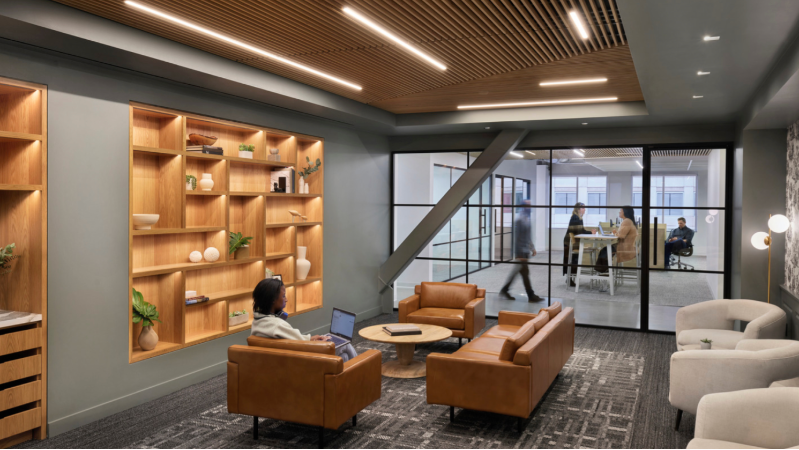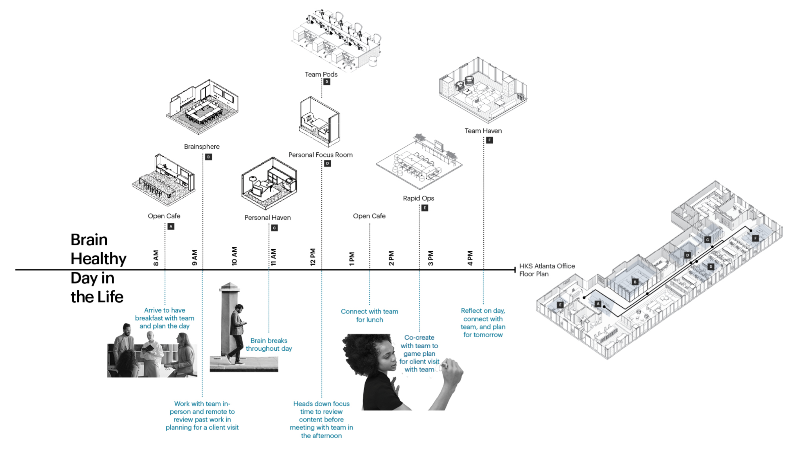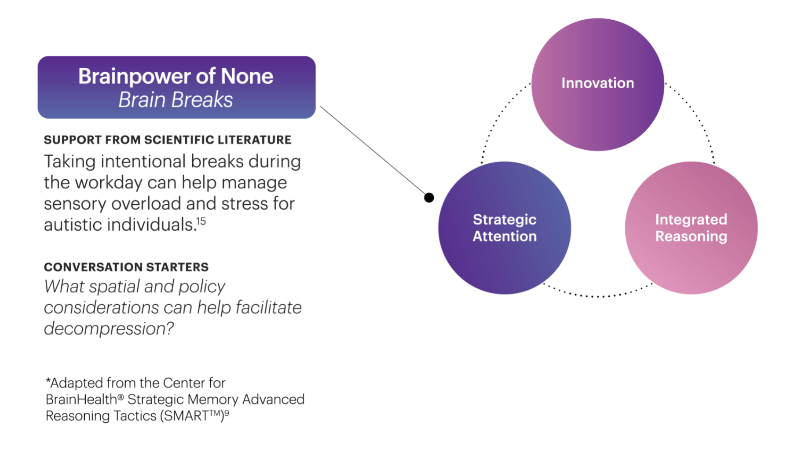Mindful Design + Mindful People = Neuroinclusive Workplaces

By Evie Guo, PhD, Cassidy Brown, Susan Chung, PhD
The following excerpt is adapted from a June 13, 2024, HKS article of the same title, and we edited it slightly from its original format.
This is a wild stat: Humans are 99.9% genetically identical. That leaves only 0.1% to bring out our uniqueness. That 0.1% includes diversity in physiological attributes and mental abilities, including differences in the way we think—or neurodiversity.
Recognizing that brain health is foundational to our well-being, we examined HKS’s workplace research on Creating a Brain Healthy Workplace with a neurodiversity lens to expand its applicability and equitability.
Neurodivergent Sensory and Cognitive Needs in Physical Spaces
Neurodiversity is the range of differences in individual brain function and behavioral traits, typically including autism spectrum disorder (ASD), attention-deficit/hyperactivity disorder (ADHD), dyslexia, dyspraxia, and Tourette syndrome. Neurodivergent people are more likely to be hypersensitive or hyposensitive to environmental stimuli, and avoiding sensory stressors in the workplace can drive engagement.
Brain Health from a Neurodiversity Lens
Brain health should be accessible to all—so workplaces have some catching up to do.
“Everyone’s brain [has] different qualities of what they hyper excel at or what they’re weak at,” says Geoff Rose, senior technical support engineer at HKS and chair of the firm’s affinity and inclusion group (AIG), Mindful: Neurodiversity & Mental Health. “Awareness of diversity has come a long way. People are aware that there are other people who are not like them, and that accommodating [other] people is a good thing.”
The Brain Healthy Workplaces Report includes nine brain health strategies, five workplace affordances (how we perceive environments to meet our needs), and three habits. While most of the framework holds true for neurotypical and neurodiverse populations, key differences exist.

Design Implications and Actionable Steps
Neurodivergent sensory needs translate into critical design strategies. Here’s a summary based on the brain-healthy workplace affordances:
- Focus Affordance: Low–medium stimulation; low–moderate interaction
Design: Ordered spacing, symmetry, neutral palette, natural materials, quiet zones, acoustical/visual privacy, lighting control
Social: Minimize interruptions, use headphones, respect concentration needs
- Exploration & Ideation (Breakout): Medium stimulation; moderate interactions for ad-hoc meetings, short discussions, breaks
Design: Tactile zones, varied upholstery textures, ergonomic furniture
Social: Keep discussions brief and noise at a reasonable level; respect privacy
- Collaboration & Co-Creation: Medium stimulation; high interaction for brainstorming, team meetings, group projects
Design: Operable windows, acoustical/visual control
Social: Respect space and contributions; use collaborative tools
- Social Connection: High stimulation; informal networking, casual discussions, team bonding
Design: Bold patterns, outdoor views, kinesthetic opportunities, away from quiet zones
Social: Casual conversations, laughter, sharing non-work topics, respecting boundaries.

A neuroinclusive workplace calls for not just a thoughtfully designed space, but also mindful people who elevate one another. This starts with awareness—from both sides.
How can we foster a creative environment where everyone thrives? The power of diversity and inclusivity can be built upon understanding team members and their unique strengths and leveraging them to build a thriving team. Neurodivergent employees are often their own best advocates and need to share how their brains work and the workplace adjustments they need to succeed.